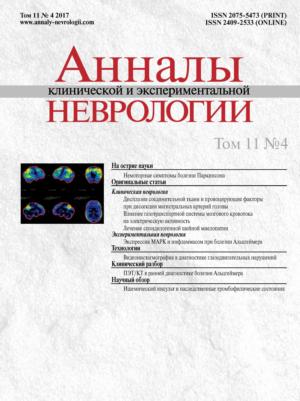Видеонистагмография в диагностике глазодвигательных нарушений
- Авторы: Белякова-Бодина А.И.1, Бриль Е.В.2, Зимнякова О.С.2, Аникина М.А.2, Брутян А.Г.1
-
Учреждения:
- ФГБНУ «Научный центр неврологии»
- ФГБУ ГНЦ Федеральный медицинский биофизический центр им. А.И. Бурназяна ФМБА России
- Выпуск: Том 11, № 4 (2017)
- Страницы: 52-64
- Раздел: Технологии
- Дата подачи: 24.12.2017
- Дата публикации: 27.12.2017
- URL: https://annaly-nevrologii.com/journal/pathID/article/view/500
- DOI: https://doi.org/10.17816/psaic500
- ID: 500
Цитировать
Полный текст
Аннотация
Видеонистагмография (ВНГ) - динамически развивающийся метод объективной количественной регистрации движений глаз при различных неврологических заболеваниях, имеющий ряд преимуществ по сравнению с методиками, которые использовались ранее. В обзоре приведены основы метода, описаны наиболее распространенные тесты на различные движения глаз. Освещены принципы исследования саккад различных типов (включая просаккады, антисаккады, саккады по памяти и произвольные саккады), а также других видов движений глаз – плавного слежения, оптокинетического нистагма. Рассмотрено, какие показатели оцениваются в каждом случае, каковы возможные отклонения в анализируемых параметрах, регистрируемые при проведении видеонистагмографии у пациентов с неврологическими заболеваниями. Приведены данные опубликованных ранее исследований, позволяющие ожидать развития методики для пресимптоматической и ранней дифференциальной диагностики ряда заболеваний, рассмотрено влияние прогрессирования различных заболеваний на показатели видеонистагмографии и их изменение под воздействием терапии. Обсуждается ценность получаемых данных для неврологов, а также невозможность объективной оценки ряда параметров глазодвигательных нарушений при рутинном неврологическом осмотре. Растущий интерес к методике и совершенствование технологии предполагает дальнейшее ее развитие и внедрение в клинику, в том числе для исследования глазодвигательной системы при нарушении когнитивных функций и исполнительной моторной функции.
Об авторах
Александра И. Белякова-Бодина
ФГБНУ «Научный центр неврологии»
Автор, ответственный за переписку.
Email: gne.na.zemle@gmail.com
Россия, Москва
Екатерина Витальевна Бриль
ФГБУ ГНЦ Федеральный медицинский биофизический центр им. А.И. Бурназяна ФМБА России
Email: gne.na.zemle@gmail.com
Россия, Москва
Ольга С. Зимнякова
ФГБУ ГНЦ Федеральный медицинский биофизический центр им. А.И. Бурназяна ФМБА России
Email: gne.na.zemle@gmail.com
Россия, Москва
Марина А. Аникина
ФГБУ ГНЦ Федеральный медицинский биофизический центр им. А.И. Бурназяна ФМБА России
Email: gne.na.zemle@gmail.com
Россия, Москва
Амаяк Грачевич Брутян
ФГБНУ «Научный центр неврологии»
Email: gne.na.zemle@gmail.com
Россия, Москва
Список литературы
- Shurupova M.A., Anisimov V.N., Latanov A.V. [Features of eye movement disorders in patients with cerebellar lesions of different localization]. Rossiyskiy mediko-biologicheskiy vestnik imeni akademika I.P. Pavlova. 2016;24(3): 154-63. (In Russ.)
- Miles R.D., Zapala D.A. Vestibular Function Measurement Devices. 2015; 1(212): 49-74. PMID: 27516710 doi: 10.1055/s-0034-1396926
- Ganança M.M., Caovilla H.H., Ganança F.F. Electronystagmography versus videonystagmography. Brazilian Journal of Otorhinolaryngology. 2010; 76(3): 399-403. doi: 10.1590/S1808-86942010000300021. PMID: 22219058.
- Bell B.B., Abel L.A., Li W. et al. Concordance of smooth pursuit and saccadic measures in normal monozygotic twin pairs. Biological psychiatry. 1994; 36(8): 522-526. PMID: 7827215.
- Pelisson D., Prablanc C. Kinematics of centrifugal and centripetal saccadic eye movements in man. Vision Research. 1988; 28(1):87-94. doi: 10.1016/S0042-6989(88)80009-9. PMID: 3414002.
- Koene A.R., Erkelens C.J. Cause of kinematic differences during centrifugal and centripetal saccades. Vision Research. 2002; 42(14): 1797-1808. doi: 10.1016/S0042-6989(02)00110-4. PMID: 3414002.
- Ettinger U., Kumari V., Crawford T.J. et al. Reliability of smooth pursuit, fixation, and saccadic eye movements. Psychophysiology. 2003; 40(4): 620-628. PMID: 14570169.
- Kubarko К.A. [Neural pathways and mechanisms of control of eye saccades and visually driven motor reactions]. Belorussky meditsinskii zhurnal. 2005; 1(11): 60-63. (In Russ.)
- Leigh R.J., Zee D.S. The Neurology of Eye Movements, 5th Edition. New York: Oxford University Press, 2015; 1136 p.
- Winograd-Gurvich C., Georgiou-Karistianis N., Fitzgerald P.B. et al. Self-paced saccades and saccades to oddball targets in Parkinson’s disease. Brain Research. 2006; 1106(1): 134-141. doi: 10.1016/j.brainres.2006.05.103. PMID: 16822490.
- Golding C.V.P., Danchaivijitr C., Hodgson T.L., et al. Identification of an oculomotor biomarker of preclinical Huntington disease. Neurology. 2006; 67(3): 485-487. doi: 10.1212/01.wnl.0000218215.43328.88. PMID: 16625001.
- Barnes G., Grealy M., Collins S. Volitional control of anticipatory ocular smooth pursuit after viewing, but not pursuing, a moving target: evidence for a re-afferent velocity store. Experimental brain research. 1997; 116(3): 445-455. PMID: 9372293.
- Steinbach M.J. Eye tracking of self-moved targets: the role of efference. Journal of experimental psychology. 1969; 82(2): 366-376. PMID: 5378050.
- Pfaltz C.R., Ildiz F. The optokinetic test: Interaction of the vestibular and optokinetic system in normal subjects and patients with vestibular disorders. Archives of Oto-Rhino-Laryngology. 1982; 234(1): 21-31. doi: 10.1007/BF00453534. PMID: 6979330.
- Astr K., Stridh M. Smooth pursuit detection in binocular eye-tracking data with automatic video-based performance evaluation Marcus Nystr o. Journal of Vision. 2017; 16(2016): 1-18. doi: 10.1167/16.15.20.doi. PMID: 28006070.
- Valmaggia C., Proudlock F., Gottlob I. Look and stare optokinetic nystagmus in healthy subjects and in patients with no measurable binocularity. A prospective study. Klinische Monatsblatter fur Augenheilkunde. 2005; 222(3): 196-201. doi: 10.1055/s-2005-858013. PMID: 15785979.
- Whalen E. D. Effects of instructions on optokinetic nystagmus (OKN). Independent Studies and Capstones. 2014; Paper 681. Program in Audiology and Communication Sciences, Washington University School of Medicine. http://digitalcommons.wustl.edu/pacs_capstones/681
- Kashou N.H., Leguire L.E., Roberts C.J. et al. Instruction dependent activation during optokinetic nystagmus (OKN) stimulation: An FMRI study at 3 T. Brain Research. 2010; 1336(1954): 10-21. doi: 10.1016/j.brainres.2010.04.017. PMID: 20403339.
- Waddington J., Harris C.M. Human optokinetic nystagmus: A stochastic analysis. Journal of Vision. 2012;12(12):5-5. doi: 10.1167/12.12.5. PMID: 23139161.
- Briand K.A., Strallow D., Hening W. et al. Control of voluntary and reflexive saccades in Parkinson’s disease. Experimental Brain Research. 1999; 129(1): 38-48. doi: 10.1007/s002210050934. PMID: 10717796.
- Michell A.W., Xu Z., Fritz D. et al. Saccadic latency distributions in Parkinson’s disease and the effects of L-dopa. Experimental brain research. 2006; 174(1): 7-18. doi: 10.1007/s00221-006-0412-z. PMID: 16544135.
- Hood A.J., Amador S.C., Cain A.E. et al. Levodopa slows prosaccades and improves antisaccades: an eye movement study in Parkinson’s disease. J Neurol Neurosurg Psychiatry. 2007; 78(6): 565-570. doi: 10.1136/jnnp.2006.099754 PMID: 17178817.
- Temel Y., Visser-Vandewalle V., Carpenter R.H.S. Saccadometry: a novel clinical tool for quantification of the motor effects of subthalamic nucleus stimulation in Parkinson’s disease. Experimental neurology. 2009; 216(2): 481-489. doi: 10.1016/j.expneurol.2009.01.007. PMID: 19320006.
- Nilsson M.H., Patel M., Rehncrona S., et al. Subthalamic deep brain stimulation improves smooth pursuit and saccade performance in patients with Parkinson’s disease. Journal of neuroengineering and rehabilitation. 2013;10(1): 33. doi: 10.1186/1743-0003-10-33. PMID: 23551890.
- Antoniades C.A., Bogacz R., Kennard C., et al. Deep Brain Stimulation Abolishes Slowing of Reactions to Unlikely Stimuli. Journal of Neuroscience. 2014; 34(33): 10844-10852. doi: 10.1523/JNEUROSCI.1065-14.2014. PMID: 25122887.
- Nemanich S.T., Earhart G.M. Freezing of gait is associated with increased saccade latency and variability in Parkinson’s disease. Clinical Neurophysiology. 2016; 127(6): 2394-2401. doi: 10.1016/j.clinph.2016.03.017. PMID: 27178858.
- Stuart S., Lord S., Hill E., Rochester L. Gait in Parkinson’s disease: A visuo-cognitive challenge. Neuroscience & Biobehavioral Reviews. 2016; 62: 76-88. doi: 10.1016/j.neubiorev.2016.01.002. PMID: 26773722
- Ewenczyk C., Mesmoudi S., Gallea C., et al. Antisaccades in Parkinson disease: A new marker of postural control? Neurology. 2017; 88(9): 853-861. doi: 10.1212/WNL.0000000000003658. PMID: 28130466
- Gitchel G.T., Wetzel P.A., Baron M.S. Pervasive Ocular Tremor in Patients With Parkinson Disease. Archives of Neurology. 2012; 69(8): 1011-7. doi: 10.1001/archneurol.2012.70. PMID: 22490323.
- Leigh R.J., Martinez-Conde S. Tremor of the eyes, or of the head, in Parkinson’s disease? Movement Disorders. 2013; 28(6): 691-693. doi: 10.1002/mds.25478. PMID: 23629728.
- MacAskill M.R., Myall D.J., Anderson T.J. “Ocular tremor” in Parkinson’s disease: A technology-dependent artifact of universal head motion? Movement Disorders. 2013; 28(8): 1165-1166. doi: 10.1002/mds.25602. PMID: 23813923.
- Otero-Millan J., Schneider R., Leigh R.J. et al. Saccades during Attempted Fixation in Parkinsonian Disorders and Recessive Ataxia: From Microsaccades to Square-Wave Jerks. PLoS ONE. 2013;8(3): e58535 . doi: 10.1371/journal.pone.0058535. PMID: 23516502.
- Garbutt S., Riley D.E., Kumar A.N. et al. Abnormalities of optokinetic nystagmus in progressive supranuclear palsy. Journal of neurology, neurosurgery, and psychiatry. 2004; 75(10): 1386-1394. doi: 10.1136/jnnp.2003.027367. PMID: 15377682.
- Pinkhardt E.H., Jürgens R., Becker W., et al. Differential diagnostic value of eye movement recording in PSP-parkinsonism, Richardson’s syndrome, and idiopathic Parkinson’s disease. Journal of neurology. 2008; 255(12): 1916-1925. doi: 10.1007/s00415-009-0027-y. PMID: 19224319.
- Termsarasab P., Thammongkolchai T., Rucker J.C., Frucht S.J. The diagnostic value of saccades in movement disorder patients: a practical guide and review. Journal of Clinical Movement Disorders. 2015; 2(1): 14. doi: 10.1186/s40734-015-0025-4. PMID: 26788350.
- Anderson T., Luxon L., Quinn N. et al. Oculomotor function in multiple system atrophy: Clinical and laboratory features in 30 patients. Movement Disorders. 2008; 23(7): 977-984. doi: 10.1002/mds.21999. PMID: 18383533.
- Mosimann U.P., Müri R.M., Burn D.J. et al. Saccadic eye movement changes in Parkinson’s disease dementia and dementia with Lewy bodies. Brain. 2005; 128(6): 1267-1276. doi: 10.1093/brain/awh484. PMID: 15774501.
- Kapoula Z., Yang Q., Vernet M. et al. Spread deficits in initiation, speed and accuracy of horizontal and vertical automatic saccades in dementia with Lewy bodies. Frontiers in Neurology. 2010; NOV(November): 1-10. doi: 10.3389/fneur.2010.00138. PMID: 21212841.
- Anderson T.J., MacAskill M.R. Eye movements in patients with neurodegenerative disorders. Nature reviews Neurology. 2013; 9(2): 74-85. doi: 10.1038/nrneurol.2012.273. PMID: 23338283.
- Burrell J.R., Hornberger M., Carpenter R.H.S. et al. Saccadic abnormalities in frontotemporal dementia. Neurology. 2012; 78(23): 1816-1823. doi: 10.1212/WNL.0b013e318258f75c. PMID: 22573637.
- Boxer A.L., Garbutt S., Seeley W.W. et al. Saccade abnormalities in autopsy-confirmed frontotemporal lobar degeneration and Alzheimer disease. Archives of neurology. 2012; 69(4): 509-517. doi: 10.1001/archneurol.2011.1021. PMID: 22491196.
- Garbutt S., Matlin A., Hellmuth J. et al. Oculomotor function in frontotemporal lobar degeneration, related disorders and Alzheimer’s disease. Brain : a journal of neurology. 2008; 131(Pt 5): 1268-1281. doi: 10.1093/brain/awn047. PMID: 18362099.
- Kapoula Z., Yang Q., Otero-Millan J. et al. Distinctive features of microsaccades in Alzheimer’s disease and in mild cognitive impairment. Age. 2014; 36(2): 535-543. doi: 10.1007/s11357-013-9582-3. PMID: 24037325.
- Lasker A.G., Zee D.S., Hain T.C. et al. Saccades in Huntington’s disease: initiation defects and distractibility. Neurology. 1987; 37(3): 364-370. PMID: 2950337.
- Peltsch A., Hoffman A., Armstrong I. et al. Saccadic impairments in Huntington’s disease. Experimental Brain Research. 2008; 186(3): 457-469. doi: 10.1007/s00221-007-1248-x. PMID: 18185924.
- Grabska N., Rudzińska M., Wójcik-Pędziwiatr M. et al. Saccadic eye movements in juvenile variant of Huntington disease. Neurologia i neurochirurgia polska. 2014; 48(4): 236-241. doi: 10.1016/j.pjnns.2014.06.003. PMID: 25168321.
- Rupp J., Blekher T., Jackson J. et al. Progression in prediagnostic Huntington disease. Journal of neurology, neurosurgery, and psychiatry. 2010; 81(4): 379-384. doi: 10.1136/jnnp.2009.176982. PMID: 19726414.
- Clark D., Eggenberger E. Neuro-ophthalmology of movement disorders. Current opinion in ophthalmology. 2012; 23(6): 491-496. doi: 10.1097/ICU.0b013e328358ba14. PMID: 23014265.
- Ingster-Moati I., Bui Quoc E., Pless M. et al. Ocular motility and Wilson’s disease: a study on 34 patients. Journal of neurology, neurosurgery, and psychiatry. 2007; 78(11): 1199-1201. doi: 10.1136/jnnp.2006.108415. PMID: 17470473.
- Jung H.-K., Choi S.Y., Kim J.-M., Kim J.-S. Selective slowing of downward saccades in Wilson’s disease. Parkinsonism & related disorders. 2013; 19(1): 134-135. doi: 10.1016/j.parkreldis.2012.05.023. PMID: 22721972.
- Abel L.A., Walterfang M., Fietz M. et al. Saccades in adult Niemann-Pick disease type C reflect frontal, brainstem, and biochemical deficits. Neurology. 2009; 72(12): 1083-1086. doi: 10.1212/01.wnl.0000345040.01917.9d. PMID: 19307542.
- Zee D.S., Yee R.D., Cogan D.G. et al. Ocular motor abnormalities in hereditary cerebellar ataxia. Brain. 1976; 99(2): 207-234. doi: 10.1093/brain/99.2.207. PMID: 990897.
- Moscovich M., Okun M.S., Favilla C. et al. Clinical evaluation of eye movements in spinocerebellar ataxias: a prospective multicenter study. Journal of neuro-ophthalmology : the official journal of the North American Neuro-Ophthalmology Society. 2015; 35(1): 16-21. doi: 10.1097/WNO.0000000000000167. PMID: 25259863.
- Rodríguez-Labrada R., Velázquez-Pérez L. Eye Movement Abnormalities in Spinocerebellar Ataxias. 2012. Spinocerebellar Ataxia, Dr. José Gazulla (Ed.), ISBN: 978-953-51-0542-8, InTech, Available from: http://www.intechopen.com/books/spinocerebellar-ataxia/eye-movement-abnormalities-in- spinocerebellar-ataxias
Дополнительные файлы








